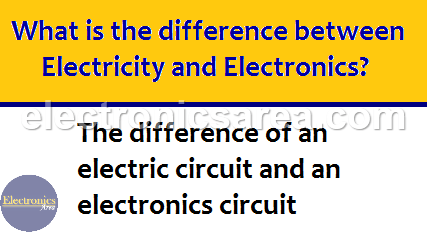What is the Difference between Electricity and Electronics?
In an electrical circuit the current flows through the conductors and components naturally, having the current, a value that depends on the components connected in the circuit.
Electricity and Electronics
The difference between electricity and electronics or the difference of an electric circuit and an electronic circuit, is that in the electronic circuit, a control is exercised over the flow of the electric current.
But this is not new, just put a switch to let flow or not the current through a light bulb. (In this way, we would be “controlling” the flow of current through the bulb).
The most important difference lies in the “how” this current flow is controlled. In an electronics circuit, an electric current flow is controlled by another electrical signal, this being another electric current flow or a fixed voltage.
In other words:
In an electronic circuit … electricity is able to control electricity.
Historically, the electronic stage starts with the Audion tube. This device controlled the flow of an electron beam, which traveled in a vacuum, between two electrodes (metal structures within the tube between which there was a difference in voltage).
In 1948, the transistor was invented. A small device with effects very similar to those of the Audion tube, but of much smaller dimensions. The transistor controls the flow of electrons through a semiconductor material instead of in a vacuum. This type of electronics is also called Solid State Electronics.
A transistor controls the flow of the current by means of current or voltage, whereas a vacuum tube controls the flow of the current only by means of voltage.
With an electrical circuit, it is not possible to send information. With an electronic circuit, information is sent from one place to another, thanks to its characteristic of being able to control the flow of the current.
Electricity is associated with the use of passive elements such as resistors, capacitors, inductors. Electronics is associated with the use of active elements such as transistors, operational amplifiers, SCR, TRIACs, etc.
For a circuit to be properly called “electronic circuit” it must contain at least one active element. If this circuit does not have active elements (it only has resistors, capacitors, inductors, transformers and even rectifier diodes, all called passive elements) it is not a genuinely “electronic” circuit.

